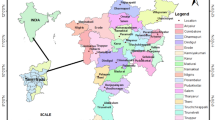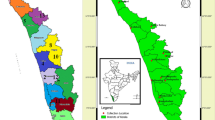Abstract
Beauveria bassiana has long been used as a mycopesticide. It has a wide host range; isolates have been reported to differ in host range and virulence to a given insect species. Identification of a molecular marker linked to a virulent phenotype to a target pest would be useful in screening for isolates effective against it. Twenty B. bassiana isolates were tested for their virulence to the second instar larvae of Chilo partellus Swinhoe in laboratory bioassays and their DNA fingerprints were generated by RAPD-PCR. Three arbitrary categories of aggressiveness were chosen; isolates that caused >70%, between 70 and 40% and <40% larval mortality were grouped as highly, medium and less aggressive types, respectively. In the random amplified polymorphic DNA (RAPD) analysis a 30% variability was observed among the isolates; which clustered into three major groups. The groups based on virulence rating did not match with the RAPD clusters. One of the highly aggressive isolates clustered with less aggressive isolates in one cluster and the other grouped along with the medium aggressive isolates in a different cluster. The B. bassiana isolates were classified phenotypically based on the taxonomic order of the original insect host and the climatic zone (tropical/temperate) from which they were isolated. No correlation between the aggressiveness of the isolate and the relatedness of the original insect host to the tested insect was observed; both the highly aggressive isolates were from coleopteran insects. A correlation was found between the RAPD grouping and the phenotypic classification of the isolates. All the lepidopteran isolates grouped into one major cluster, most sub clusters were constituted by isolates from the same climatic zone.
Similar content being viewed by others
References
Abbott, W.S. 1925 A method of computing the effectiveness of an insecticide. Journal of Economic Entomology 18, 265–267.
Bridge, P.D., Abraham, Y.J., Corhish, M.C., Prior, C. & Moore, D. 1990 The chemotaxonomy of Beauveria bassiana (Deuteromycotina:Hyphomyetes) isolates from the coffee berry borer Hypothenemus hampei (Coleoptera:Scolytidae). Mycopathology 111, 85–90.
Berretta, M.F., Lecuona, R.E., Zandomeni, R.O. & Grau, O. 1998 Genotyping isolates of the entomopathogenic fungus Beauveria bassiana by RAPD with fluorescent labels. Journal of Invertebrate Pathology 71, 145–150.
Castrillo, L.A. & Brooks, W.M. 1998 Differentiation of Beauveria bassiana isolates from the darkling beetle, Alphitobius diaperinus, using isozyme and RAPD analyses. Journal of Invertebrate Pathology 72, 190–196.
Cooke, D.E.L., Kennedy, D.M., Guy, D.C., Russell, J., Unkles, S.E. & Duncan, J.M. 1996 Relatedness of Group 1 species of Phytophthora as assessed by randomly amplified polymorphic DNA (RAPDs) and sequences of ribosomal DNA. Mycological Research 100, 297–303.
Couteaudier, Y. & Viaud, M. 1997 New insights into population structure of Beauveria bassiana with regard to vegetative compatibility groups and telomeric restriction fragment length polymorphisms. FEMS Microbiology Ecology 22, 175–182.
Crowhurst, R.N., King, F.Y., Hawthorne, B.T., Snderson, F.R. & Choi-pheng, T. 1995 RAPD characterization of Fusarium oxysporum associated with wilt of angsana (Pterocarpus indicus) in Singapore. Mycological Research 99, 14–18.
Ferron, P., Fargues, J. & Riba, G. 1991 Fungi as microbial insecticides against pests. In Handbook of Applied Mycology: Humans, Animals and Insects, eds. Arora, D.K., Mukherji, K.G. & Drouhet, E. vol. 2, pp. 665–705. New York: Marcel Dekker. ISBN 0–82478435–9.
Genstat 4 Committee 1983 Genstat 4 Reference Manual. Numerical algorithms group Ltd: Oxford.
Glare, T.R. & Inwood, A.J. 1998 Morphological and genetic characterisation of Beauveria spp. from New Zealand. Mycological Research 102, 250–256.
Gomez, A.K. & Gomez, A.A. 1984 Statistical Procedures for Agricultural Research, pp. 643–645. Singapore: John Wiley & Sons, Inc. ISBN 0–471–87931–2.
Goodwin, P.H. & Annis, S.L. 1991 Rapid identification of genetic variation and pathotype of Leptosphaeria maculans by random amplified polymorphic DNA assay. Applied and Environmental Microbiology 57, 1482–1486.
Humber, R.A. 1991 Fungal pathogens of aphids. In Proceedings, Aphid-plant Interactions. Populations to Molecules, pp. 45–56, MP-132, Oklahoma Agricultural Station, Stillwater, Oklahoma.
Lacey, L.A. & Goettel, M.S. 1995 Current developments in microbial control of insect pests and prospects for the early 21st century. Entomophaga 40, 3–27.
Leathers, T.D., Gupta, S.C. & Alexander, N.J. 1993 Mycopesticides: status, challenges and potential. Journal of Industrial Microbiology 12, 69–75.
Leal, S.C.M., Bertioli, D.J., Butt, T.M. & Peberdy, J.F. 1994 Characterization of isolates of the entomopathogenic fungus Metarhizium anisopliae by RAPD-PCR. Mycological Research 98, 1077–1081.
Lee, S.B. & Taylor, J.W. 1990 Isolation of DNA from fungal mycelia and single conidia. In PCR protocols. A Guide to Methods and Applications, eds. Innis, M.A., Gelfand, D.H., Sinsky, J. J. & White, T.J. pp. 282–287. New York: Academic Press. ISBN 0–123–72181–4.
Luz, C., Tigano, M.S., Silva, I.G., Corderio, C.M. & Aijanabi, S.M. 1998 Selection of Beauveria bassiana and Metarhizium anisoplae isolates to control Triatoma infestans. Memorias do Instituto Oswaldo Cruz 93, 839–846.
Maniania, N.K. 1998 Evaluation of three formulations of Beauveria bassiana (Bals.) Vuill. for control of the stem borer Chilo partellus (Swinhoe) (Lep., Pyralidae). Journal of Applied Entomology 115, 266–272.
Maurer, P., Couteaudier, Y., Girard, P.A., Bridge, P.A. & Riba, G. 1997 Genetic diversity of Beauveria bassiana and relatedness to host insect range. Mycological Research 101, 159–164.
Mills, P.R., Sreenivasaprasad, S. & Brown, A.E. 1992 Detection and differentiation of Colletotrichum gleosporoides isolates using PCR. FEMS Microbiology Letters 98, 137–143.
McCoy, C.W., Samson, R.A. & Boucias, D.G. 1988 Entomogenous fungi. In CRC Handbook of Natural Pesticides. Volume V: Microbial Insecticides. Part A. Entomogenous Protozoa and Fungi, eds. Ignoffo, C.M. & Mandava, N.B. pp. 151–236. Boca Raton: CRC Press. ISBN 0–84933660–0.
Nei, M. & Li, W.H. 1979 Mathematical model for studying genetic variation in terms of restriction endonucleases. Proceedings of the National Academy of Sciences, USA. 76, 5269–5273.
Pfeifer, T.A. & Khachatourians, G.G. 1993 Isolation of DNA from entomopathogenic fungi grown in liquid cultures. Journal of Invertebrate Pathology 61, 113–116.
Seshu Reddy, K.V. & Davies, C.J. 1978 A new method for mass rearing of the sorghum shoot borer, Chilo partellus Swinhoe (Lepidoptera: Pyralidae) and its use in resistance screening. Indian Journal of Plant Protection 6, 48–55.
Sokal, R.R. & Rohlf, F.J. 1962 The comparision of dendrograms by objective methods. Taxon 11, 33–40.
St. Leger, R.J., Allee, L.L., May, B., Staples, R.C. & Roberts, D.W. 1992 World-wide distribution of genetic variation among isolates of Beauveria spp. Mycological Research 96, 1007–1015.
Varela, A. & Morales, E. 1996 Characterization of some Beauveria bassiana isolates and their virulence toward the Coffee berry borer Hypothenemus hampei. Journal of Invertebrate Pathology 67, 147–152.
Viaud, M., Couteaudier, Y. & Riba, G. 1996 Genomic organisation of Beauveria bassiana: electrophoretic karyotyping, gene mapping and telomeric fingerprinting. Fungal Genetics and Biology 20, 175–183.
Weising, K., Nybom, H., Wolff, K. & Meyer, W. 1994 DNA Fingerprinting. In Plants and Fungi, pp. 209–217. Boca Raton: CRC Press. ISBN 0–8493–8920–8.
Williams, J.G.K., Kubelik, A.R., Livak, K.J., Rafalski, J.A. & Tingey, S.V. 1990 DNA polymorphisms amplified by arbitrary primers are useful as genetic markers. Nucleic Acids Research 18, 6531–6535.
Author information
Authors and Affiliations
Rights and permissions
About this article
Cite this article
Devi, K.U., Padmavathi, J., Sharma, H. et al. Laboratory evaluation of the virulence of Beauveria bassiana isolates to the sorghum shoot borer Chilo partellus Swinhoe (Lepidoptera: Pyralidae) and their characterization by RAPD-PCR. World Journal of Microbiology and Biotechnology 17, 131–137 (2001). https://doi.org/10.1023/A:1016633427739
Issue Date:
DOI: https://doi.org/10.1023/A:1016633427739




